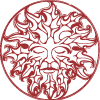
“Ride a cock horse to Banbury Cross” - September 2008

This Mother Goose rhyme evokes an image of a youngster hopping along astride a simple stick with a horse’s head affixed to one end. Propelled by young legs in a galloping gait, and amended by youthful imagination, the traditional plaything, called a “cock horse” or “hobbyhorse”, is even today a common feature of childhood play.
But the hobbyhorse also enjoys a central role in more adult festivals and rituals. Indeed, astute Revelers will note at least three instances where the hobbyhorse makes an appearance in our various seasonal celebrations.
Every Spring, our May Day events at the Oakland Zoo and the Pelican Inn are graced by the appearance of our very own version of the “Padstow Wee ‘Oss”. This is a rather bizarre creation, some six feet in diameter with a horse’s head and tail, surmounted by a grotesque bearded visage, crowned with a tall pointed hat. Dancing along behind a “teaser” who leads him through the crowd, the Wee Oss cavorts to the tune of the Padstow May song, capering, shimmying and occasionally snapping at bystanders. To be “captured” by this creature (drawn beneath its voluminous black skirt) is supposed to bring good luck.
In Cornwall, there are actually two of these horses – the Blue or “Peace” ‘Oss and the Red or “Old” Oss. Ours is a replica of the latter. While the Padstow animal might put one in mind of a large black dancing card table, in Somerset, the town of Mineshead features an even stranger creation. Here a “Town” horse and a “Sailors’” horse compete, looking for all the world like two large boats, bedecked with ribbons and scraps of fabric. Surrounded by revelers called “Gullivers”, these horses also appear at the beginning of May in celebration of the return of Summer.
The hobbyhorse that you’ll see onstage at the Christmas Revels is a much less grandiose creation. It consists a little more than a skirted hoop with a simple head and tail worn by the rider (usually Jonathon Moon) in the Abbots Bromley dance, and occasionally in the mummers’ play. This horse is based on a type whose association with the Morris and mumming tradition can, through visual evidence be dated to the early 17th century.
While the hobbyhorse is at best an infrequent and minor character in the mummers’ play, he is a much-anticipated and important element of the Abbots Bromley horn dance. One of the four “supernumerary” characters, hobby horse trots along in the footsteps of the deer dancers, following the serpentine patterns and joining in the clash opposite the Man/Woman character.
So, where does the name “hobby” come from, and why is it connected to this figure? As is usual in such matters, opinions differ and experts point with equal vehemence to differing (and usually contradictory) sources. Here’s a plausible explanation: according to Samuel Johnson, hobbies were small active horses, originally from Ireland. The word itself may very well have come from Scandinavia where the Swedish “hoppa” meant “to jump”. Apparently Henry VIII was fond of horse racing, and so his interest in “hobbying” gave us the term “hobby” to refer to a recreational activity.
If you’d like to see the Padstow “Old ‘Oss” in action, or
witness the excitement preceding the “Old “Oss’ “ arrival.
DISCLAIMER- contains a parade of more accordions than most normal people can tolerate (still, it’s fascinating to imagine the scene inside this pub).
The term “hobbyhorse” can also refer to a type of early bicycle,like this one.
- David Parr, Artistic Director



